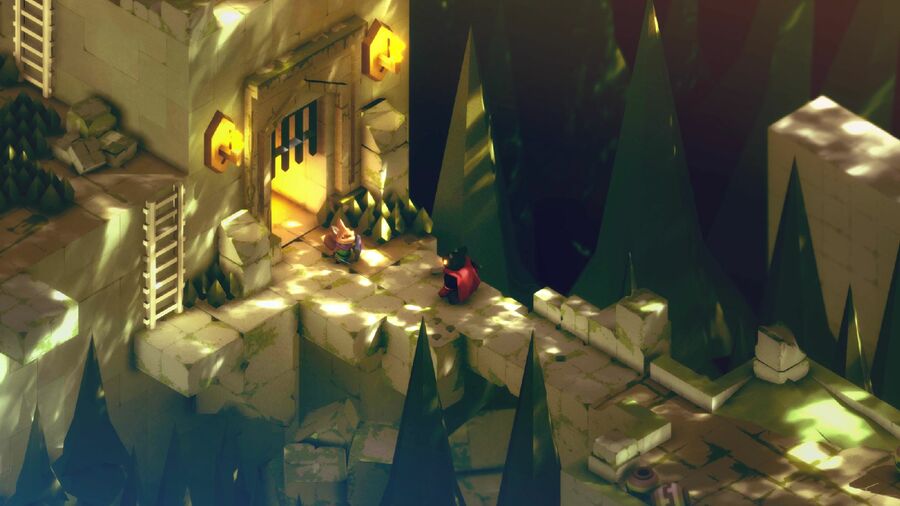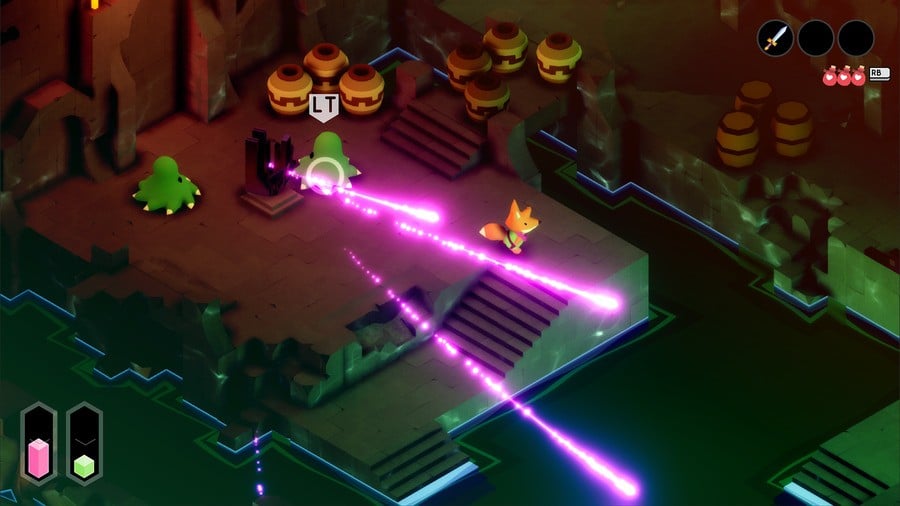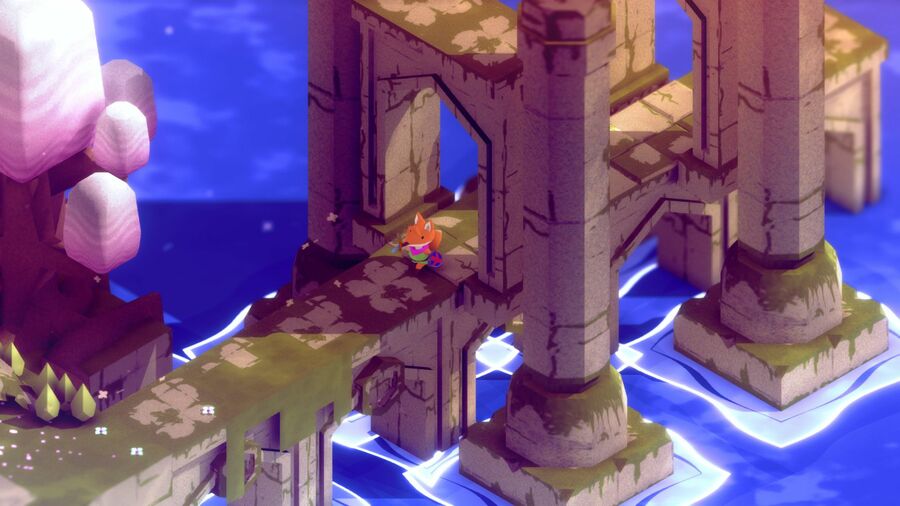
It seems like a long old time since we first clapped eyes on the delightful Tunic during its E3 2017 teaser trailer presentation. Ever since that first little glimpse we've been very excited to get our hands on this stylish Zelda-esque action-adventure and, with the release date now just days away, we've had a chance to have a chat with its creator, Andrew Shouldice, about his game's wonderful art style as well as the inspirations and influences that played a role in how Tunic has finally taken shape.
Pure Xbox: Hi Andrew, thanks for taking the time to chat to us here at Pure Xbox. Tunic has been grabbing the attention of press and gamers alike ever since it was first revealed, a reveal that really is quite a ways back now. How long will this one actually have been in development once it rolls around to your official release date of March 16th ?
Andrew Shouldice, Developer: Hello and thank you! Tunic has been in development in one form or another for just over seven years.
With such a long incubation period it’s perhaps natural that certain aspects of a project are going to change, evolve or even get cut entirely as a game is carefully shaped into its final form. Can you tell us anything about any standout late additions or cuts that you’ve made along the way that had a noticeable impact on how Tunic plays?
AS: Most of what we’ve been up to lately is polish and fine-tuning, but there have been some subtle late additions. As we approach release, the urge to put in “one last secret” is very strong, so we’ve managed to sneak in a handful of extra surprises.

Is there a constant fear or worry when you undertake a project like this, that certain aspects of what you’re making are going to date badly or become outmoded by the time you get around to releasing? If so, how do you make peace with this kind of thing and continue to work on perfecting what you’ve got regardless?
AS: Yeah, absolutely. Paying careful attention to feedback and being critical of existing design motivation is super important with that. It’s easy to think “but that’s the way the game is” and ignore all the signs that point to changing something. Similarly, when I want to make an important change I will typically talk it out with folks to make sure I’m not acting prematurely. Doing playtests and listening carefully helps a lot.
The beautiful art style of this game is something that immediately captures our attention every time we happen to catch a trailer or some gameplay footage, and it’s something that seems to have remained a constant since the very first teasers. Can you tell us a little about the style you’ve employed and its influences, what games or other forms of media have contributed to the look and feel of this magical world that players are going to explore?
AS: Thank you! Visually, the game draws from a few places. I really love things that use an isometric perspective, whether it’s a game like Monument Valley, or a cool cutaway map of a castle or dungeon. Over the years, the look of the game has evolved — it started extremely simply with barely any texture at all, but has slowly accrued detail while still trying to stay true to its geometric roots.

There are some obvious Zelda influences in the gameplay that we’ve seen from Tunic so far, but there are sprinkles of other titles in there too. What aspects of the Zelda series have you really dug into here, and what other games have you played, either before or during development, that you feel have maybe seeped their way into the mechanical aspects of Tunic?
AS: Of all the Zelda games, the one I find myself thinking of most is the very first one. It’s been talked about many times, but the original The Legend of Zelda’s promise of a big world to explore is still an exciting thought for me.
Before starting work on Tunic I had played Souls games and really admired their world design. Despite the gloomy mood, those games have a marvellous sense of mystery about them. (And it was probably digging into Bloodborne that had the most direct kinaesthetic influence on the game.)

Aside from the straightforward influences of various media, do you feel there’s much in the way of life and personal experiences that have played a part in the vibe of Tunic, in the atmosphere and story that we’ll get to experience when we finally get our hands on the game?
AS: When I was very little, I loved poring over game manuals — or “Instructions Booklets” as they sometimes called themselves. I still love reading them today of course, but back then, they were very mysterious objects. I remember being at my next door neighbour's house while they were playing Metroid 2 on the Game Boy. That screen didn’t really allow for comfortable over-the-shoulder viewing, so I had to content myself with leafing through the booklet.
We’ve tried to evoke those same feelings of wonder in Tunic. As you play, you’ll collect pages of the game’s manual, which you can bring up at any time. They’re not just collectables though — just like those old manuals, the pages are full of maps, secrets, and important tips.
We can quite clearly see from gameplay trailers that our fox protagonist utilises plenty of tools on his adventures. Besides the grapple/whip, torch and weapons, can you give us any details about some other items we might be using during our time in this world and to what extent have these various gizmos been worked into traversal and boss fights?
AS: A lot of those are secrets for now, but one of the things I value in games like this is when the requirements of item-based gates (“use key on door” for instance) are not actually as strict as they appear. Similarly, I vastly prefer boss-fight tool loadouts to be a matter of experimentation and preference, rather than there being a correct, puzzleboss-style solution.

In terms of boss battles in particular, there are some pretty amazing flashes of action in a few of Tunic’s trailers, with some fairly enormous looking foes to get to grips with. How have you approached difficulty here, is it something that fits with the cute overall vibe of the game’s style or are looks deceptive in this respect?
AS: I like to think that visual appeal and challenge are orthogonal concepts, and not on either end of a single axis. The aim is to have a game that offers an exciting challenge while still being nice to look at! Don’t get me wrong, I also love grim worlds — but I also love bright sunshiny ones. There’s also something to be said for contrast, where the demand for bravery maybe hits a little harder when you’re playing as a cute little fox.
Tunic was originally known as Secret Legend during the earlier parts of its development, was this always meant as a working title or was there another reason for the change to Tunic?
AS: It was very much a working title that just stuck around for longer than it should have. It didn’t take long for us to realise that it was just not very memorable. At our very first show, people would talk excitedly about “Fox Game” but Secret Legend just kind of slid off people’s brains.
You’ve spoken in the past about some later entries in the Zelda series becoming “comfort food” in terms of them giving you what you want from a Link adventure whilst sticking to established conventions and towing the line in terms of progression. Can we expect a much more free-form and flexible approach to progression in Tunic? Is it possible to cut your own path through this adventure?
AS: The comfortable patterns in latter-day Zeldas (Breath of the Wild excepted, I think) are appealing to a lot of people, but what really fills me with joy is when a game makes you feel like you’re truly exploring. I want to miss things, because that means when I do find something, it’s a real discovery. I absolutely love secrets that make me think “wait, this was here the whole time!?”
As far as paths go — players will probably take one of a few routes through the game, but will discover as they go that it’s possible to do things very differently, if so they choose.

You’ve also spoken a little in the past about the secrets and puzzles aspects of your game. What kind of challenge can we expect to face in this regard and what other puzzle games did you perhaps look to for inspiration when setting about creating the challenges here?
AS: My favourite type of puzzles tend to skew away from the room-by-room, light-the-torches-in-the-right-order-to-progress sort of puzzle, and more in the direction of subtle secrets that don’t try and draw a lot of attention. Depending on your definition of puzzle, it’s possible for people to finish Tunic without “solving” any “puzzles”.
With developing for Xbox in particular, were there any specific challenges you faced with the consoles and can you tell us if there are any differences we should expect between the Series X, S and Xbox One versions of the game? Are there any performance or visual differences between the various versions of Tunic?
AS: We’ve tuned the experience for the different Xbox consoles. For example, players on Xbox Series X will see a higher resolution and framerate.
And finally, now that Tunic’s release date is just around the corner, what’s next for Andrew Shouldice, is it time for a well-earned rest or should we be looking to a Tunic 2 reveal in the near future?
AS: I imagine I’m going to be working on Tunic for a little while longer, handling support and so on, but I think at some point I’m going to take a break for a bit.
But I mean “Two-nic”, it’s right there, isn’t it?
(that’s a joke!)
A huge thanks to Andrew Shouldice for taking the time out to speak with us in the run up to Tunic's launch and to James Bartholomeou for helping to arrange the interview. Will you be diving into Tunic when it launches on March 16th? Let us know in the comments!
Comments 9
This looks great and great interview. Reminds me of deaths door last year.
Once this game comes to Game Pass i will be all over it.
@lolwhatno No it's not.... especially if it's 6 months later when sales have dried up Microsoft comes in and gives them money to be on game pass. Win Win.
Ugh. I enjoyed the demo immensely and plan to buy this if the reviews are good but.....
....NOT EVERY GAME HAS TO BE LIKE DARK SOULS!
I liked the demo, but only liked it, didn’t love it. Hopefully it’s deeper than the demo suggested.
Will wait for reviews. 🤞
Looks like Death's Door.
@themightyant if you haven't tried it out already, then you should. It does definitely go WAY deeper over time. The discovery piece is probably what does it for me. It's a masterpiece in my opinion.
@ColeTD thank you! I’m VERY happy I was wrong and it was indeed a lot deeper than the demo. If it wasn’t on Game Pass the demo might have put me off. Instead I played it as soon at it launched on Game Pass and got 1000 Gamerscore.
Agreed it’s an absolute masterpiece, one of the best games I’ve played in recent years. Every screen is full of secrets hiding in plain sight. It’s truly great game design - the ‘manual’ is one of the most unique and innovative game mechanics and deserves particular praise, but secrets are everywhere. My second play through was a lot of fun armed with so much more knowledge.
P.S. If you liked that, while it’s a little different Death’s Door is also a masterpiece imho. Not as laden in secrets but tighter gameplay, a great story also with hidden depths. Another one not to sleep on.
Viva Game Pass
@themightyant Thanks! I'll have to check it out.
Leave A Comment
Hold on there, you need to login to post a comment...